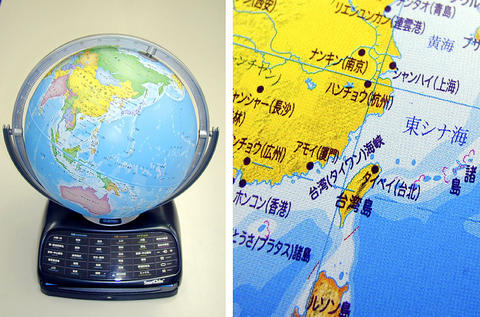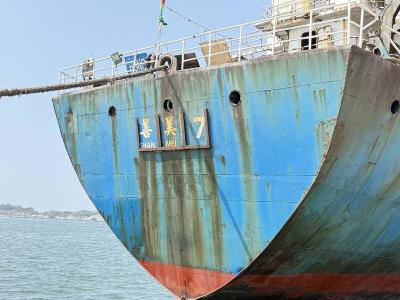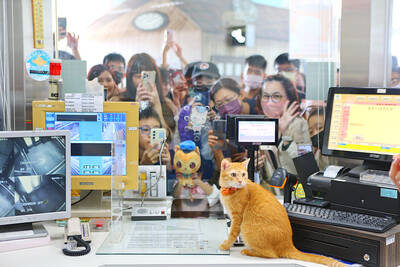An educational globe toy portraying Taiwan as a part of China at the insistence of Beijing is to be withdrawn, the Japanese firm that makes it said yesterday.
The talking "Smart Globe," aimed at Japanese children, gives information about countries when they are touched.
The ?29,400 (US$270) globe, manufactured in China by Japan's Gakken Toys Co Ltd, a subsidiary of Gakken Co Ltd, proved to be popular, with the first batch of 10,000 quickly selling out after its release last year.

PHOTO: AFP
The globe shows "Taiwan Island" and says that it is "the People's Republic of China," the official name of communist China.
Gakken said it had received complaints and apologized for its "inappropriate expression and display" on the globe.
"We deeply apologize for causing a tremendous nuisance," the company said in a statement.
It said it had advised subsidiary Gakken Toys to stop selling the globe. The group will offer full refunds starting next week for those already sold.
A Gakken spokesman said the company had initially planned simply to display "Taiwan," as is standard in Japanese school textbooks, but Beijing intervened.
"The place of production was China," he said. "The Chinese government's stance was that we could not export unless we changed the expression."
"We obeyed it although we had wavered on if we should follow the Chinese instructions or give up" on the product, he said. "We have faced accusations that we lack common sense."
A similar globe by another Japanese manufacturer does not speak even if the user touches Taiwan.
Japan only recognizes Beijing, which considers Taiwan to be as a part of China.
Since it switched diplomatic recognition from Taipei to Beijing in 1972, Tokyo has barred official contacts with Taiwan, a former Japanese colony, even though Taiwan enjoys widespread sympathy among Japanese conservatives.

An undersea cable to Penghu County has been severed, the Ministry of Digital Affairs said today, with a Chinese-funded ship suspected of being responsible. It comes just a month after a Chinese ship was suspected of severing an undersea cable north of Keelung Harbor. The National Communications and Cyber Security Center received a report at 3:03am today from Chunghwa Telecom that the No. 3 cable from Taiwan to Penghu was severed 14.7km off the coast of Tainan, the Ministry of Digital Affairs said. The Coast Guard Administration (CGA) upon receiving a report from Chunghwa Telecom began to monitor the Togolese-flagged Hong Tai (宏泰)

A cat named Mikan (蜜柑) has brought in revenue of more than NT$10 million (US$305,390) for the Kaohsiung MRT last year. Mikan, born on April 4, 2020, was a stray cat before being adopted by personnel of Kaohsiung MRT’s Ciaotou Sugar Refinery Station. Mikan was named after a Japanese term for mandarin orange due to his color and because he looks like an orange when curled up. He was named “station master” of Ciaotou Sugar Refinery Station in September 2020, and has since become famous. With Kaohsiung MRT’s branding, along with the release of a set of cultural and creative products, station master Mikan

RISING TOURISM: A survey showed that tourist visits increased by 35 percent last year, while newly created attractions contributed almost half of the growth Changhua County’s Lukang Old Street (鹿港老街) and its surrounding historical area clinched first place among Taiwan’s most successful tourist attractions last year, while no location in eastern Taiwan achieved a spot in the top 20 list, the Tourism Administration said. The listing was created by the Tourism Administration’s Forward-looking Tourism Policy Research office. Last year, the Lukang Old Street and its surrounding area had 17.3 million visitors, more than the 16 million visitors for the Wenhua Road Night Market (文化路夜市) in Chiayi City and 14.5 million visitors at Tainan’s Anping (安平) historical area, it said. The Taipei 101 skyscraper and its environs —

Taiwan on Friday said a New Zealand hamburger restaurant has apologized for a racist remark to a Taiwanese customer after reports that it had first apologized to China sparked outrage in Taiwan. An image posted on Threads by a Taiwanese who ate at Fergburger in Queenstown showed that their receipt dated Sunday last week included the words “Ching Chang,” a racial slur. The Chinese Consulate-General in Christchurch in a statement on Thursday said it had received and accepted an apology from the restaurant over the incident. The comment triggered an online furor among Taiwanese who saw it as an insult to the